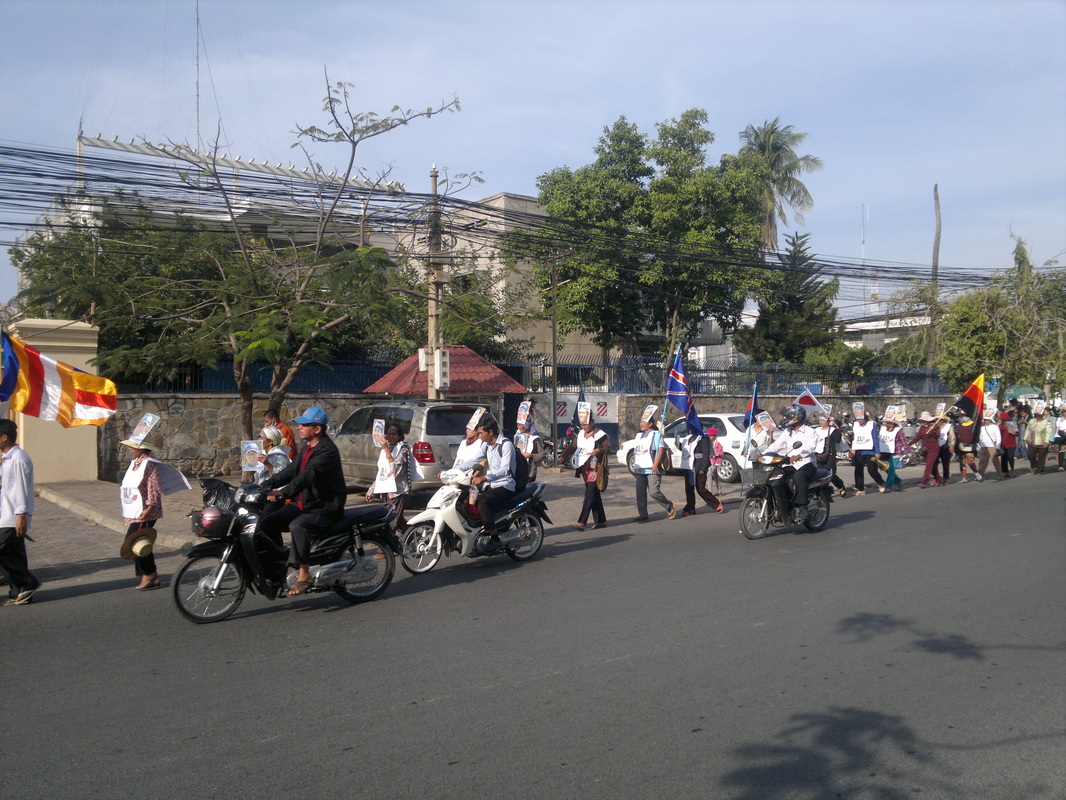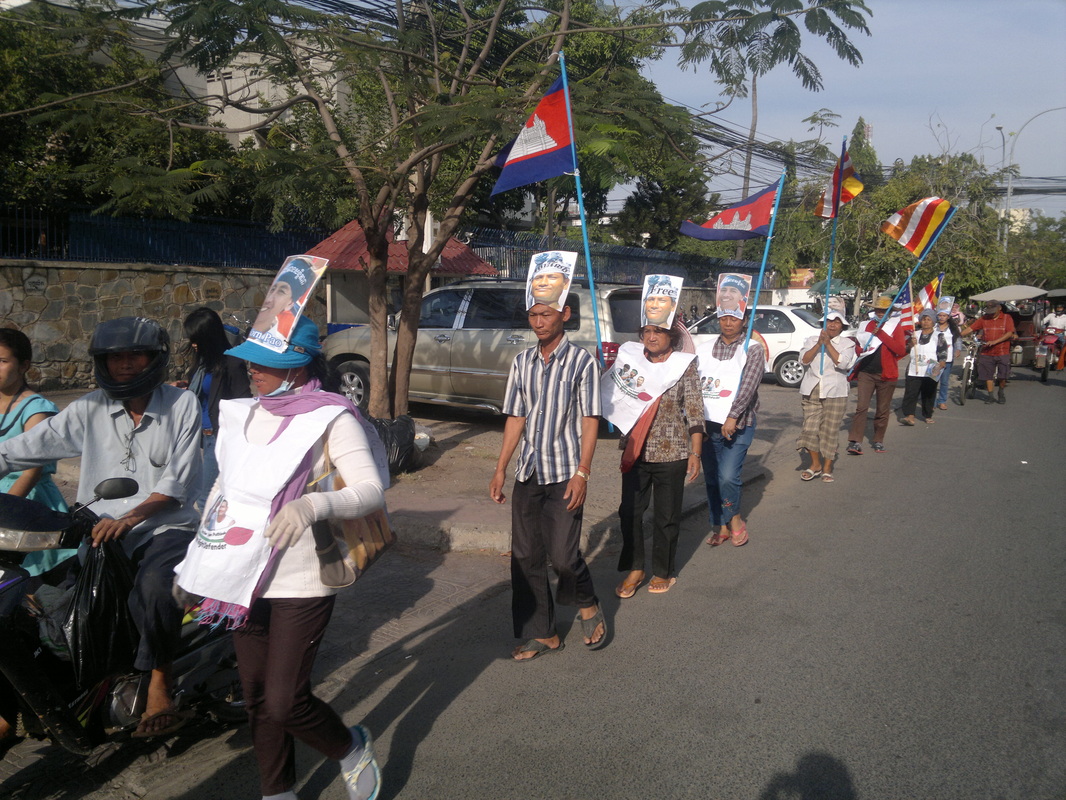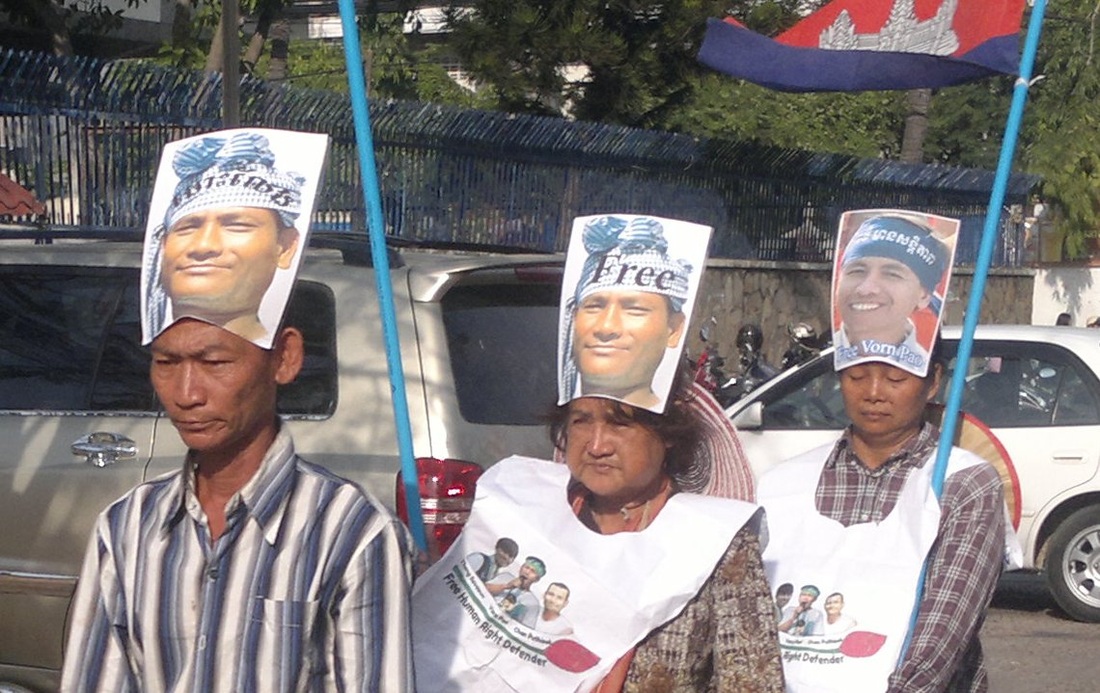Walking to an interview on a gorgeous afternoon in Phnom Penh today I was distracted by a column of several dozen protesters with motorcycle and tuk-tuk escorts making their way off Rue de Pasteur onto Samdech Pan (Street 214).
As motos and tuk-tuks sounded their horns, the protesters chanted as they marched with flags, lots of flags. The Cambodian flag was most prominent, followed by the Buddhist flag (see leftmost flag in the above image), but the banners of the EU, US, Japan, South Korea and Germany, among others, were also flown.
This small-scale march was an attempt to call domestic and international attention to the plight of 23 activists, union leaders and laborers involved in the garment worker strike and protests that climaxed the morning of January 3, when police shot and killed four protesters. The workers were demanding a pay rise from $80 per month to $160 per month for their sweatshop labor, which produces garments for companies including Gap, H&M, and Levi's. Garments account for 80 percent of Cambodia's exports.
On January 8, the government announced that the jailed protesters were being held in Kampong Cham's Correctional Center 3, which is famous for poor treatment of inmates. Several of the jailed are reportedly suffering from injuries sustained during beatings before and after their detention.
The day after the crackdown in Phnom Penh's garmentmaking district, military police and plainclothes gangs cleared hundreds of opposition protesters from Freedom Park, after which the government, led by Prime Minister Hun Sen, banned further demonstrations. However, two weeks later this tiny demonstration shows how difficult it will be for Hun Sen to make the issues of last year's questionable elections and resentment toward government corruption just go away.
Hun Sen leads the Cambodian People's Party, which has ruled the Kingdom since the Vietnamese overthrow of the Khmer Rouge regime in 1979. A former Khmer Rouge soldier himself, he is generally regarded as a dictator.
Back to the demonstration, most of those who were on foot donned photos of jailed protesters on their heads. The photos featured the names of the protesters as well as Khmer- and English-language calls for their release.
The government may have quashed demonstrations by garment workers and opposition supporters, but as today's small protest suggests, Cambodians have not been completely scared off the streets. It seems highly unlikely that Hun Sen's government will not have to deal with large-scale protests again during the remaining four-plus years of his current term.
As motos and tuk-tuks sounded their horns, the protesters chanted as they marched with flags, lots of flags. The Cambodian flag was most prominent, followed by the Buddhist flag (see leftmost flag in the above image), but the banners of the EU, US, Japan, South Korea and Germany, among others, were also flown.
This small-scale march was an attempt to call domestic and international attention to the plight of 23 activists, union leaders and laborers involved in the garment worker strike and protests that climaxed the morning of January 3, when police shot and killed four protesters. The workers were demanding a pay rise from $80 per month to $160 per month for their sweatshop labor, which produces garments for companies including Gap, H&M, and Levi's. Garments account for 80 percent of Cambodia's exports.
On January 8, the government announced that the jailed protesters were being held in Kampong Cham's Correctional Center 3, which is famous for poor treatment of inmates. Several of the jailed are reportedly suffering from injuries sustained during beatings before and after their detention.
The day after the crackdown in Phnom Penh's garmentmaking district, military police and plainclothes gangs cleared hundreds of opposition protesters from Freedom Park, after which the government, led by Prime Minister Hun Sen, banned further demonstrations. However, two weeks later this tiny demonstration shows how difficult it will be for Hun Sen to make the issues of last year's questionable elections and resentment toward government corruption just go away.
Hun Sen leads the Cambodian People's Party, which has ruled the Kingdom since the Vietnamese overthrow of the Khmer Rouge regime in 1979. A former Khmer Rouge soldier himself, he is generally regarded as a dictator.
Back to the demonstration, most of those who were on foot donned photos of jailed protesters on their heads. The photos featured the names of the protesters as well as Khmer- and English-language calls for their release.
The government may have quashed demonstrations by garment workers and opposition supporters, but as today's small protest suggests, Cambodians have not been completely scared off the streets. It seems highly unlikely that Hun Sen's government will not have to deal with large-scale protests again during the remaining four-plus years of his current term.



 RSS Feed
RSS Feed